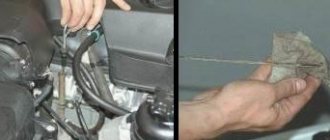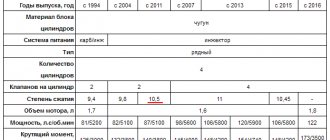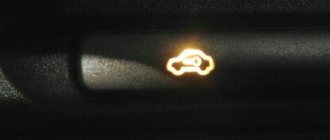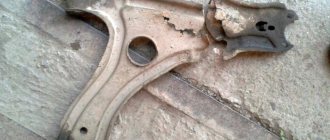Cars of the Chevrolet Niva model received the VAZ-2123 engine, which is quite powerful for this type of car, the main design features of which are a 4-cylinder vertical mechanism. The Chevrolet Niva engine has a built-in fuel injection control system and also complies with European Euro 2 standards for toxic emissions.
Comparing the new modification of the VAZ-2123 with previous analogues, one immediately notices one of the main advantages for the motorist - reduced noise level. This result was achieved thanks to the use of hydraulic chain tensioners, as well as a single-row chain device.
The reason for the reduced noise production is the presence of a hydraulic support for the valves. This engine has one more difference from previous models of this engine - the ability to install knock sensors on the cylinder blocks, which is provided by the bosses.
History of the Niva Chevrolet engine
In 2001, the Niva trademark ended its development. At the same time, the production of domestic SUVs has not disappeared anywhere. The newly created joint venture between GM and AVTOVAZ became the owner of a unique brand of Russian SUV. Further development and production of the Niva began under the name LADA 4x4.
JV AVTOVAZ - GM set themselves the task in a year to create a new model of an SUV that will have the cross-country ability of a Niva and the comfort and build quality of a foreign car. They decided to call the car of joint production Chevrolet-Niva. This model was designed on the basis of already well-proven Niva models with a volume of 1.7 liters. But it was a completely different car, to which numerous changes were made compared to the base VAZ 21214.
The main change in the Niva-Chevrolet is, first of all, a completely new body with a modern shape, a bumper painted to match the color of the car, and permanent four-wheel drive. The transmission, tested by time and life, remains from the previous Niva.
Some mechanisms have undergone major changes:
- The design of the front axle has been changed; it does not have a permanent connection with the engine;
- the intermediate shaft received a more elongated design;
- the design of the gearbox drive has undergone changes;
- the transfer case uses sprockets with finely modular gearing;
- The clutch system on the VAZ 2123 is original;
- The gearbox has undergone significant changes, seals and gaskets, the gearbox mechanism, and main bearings have been replaced;
- both cardan shafts were unified.
The noise from the engine inside the car has become much quieter. This indicates that all the parts and components of the car are tightly fitted, the car was assembled with high Chevrolet quality.
The power plant of the Chevrolet Niva, a modified copy of the VAZ 21214. It retains the valve lifters and on the timing drive, a hydraulic tensioner is installed for a single-row camshaft chain. The camshaft phases were expanded, this innovation made it possible to increase torque at low speeds.
The basic version of the Chevrolet is equipped with a 1.7 liter engine with distributed fuel injection, the power of which is 80 hp. The combustion product exhaust system has a catalytic converter. This allows the VAZ 2123 engine to comply with European emission standards Euro 3 and Euro 2. The VAZ 2123 engine was specially designed and created for the Chevrolet Niva. However, for an SUV with a total loaded weight of 1.8 tons, such an engine turned out to be rather weak. Therefore, Chevrolet will be equipped with gasoline and diesel engines from GM and FIAT, respectively. Back in 2003, an export version was developed, which was equipped with a powerful engine from Opel. This model was mainly exported and was much more expensive.
Description of the power unit
VAZ 2123 - the power unit installed on the Lada 4x4 is a modified, modified version of the engine of the 21214 model. This is the same four-cylinder gasoline engine, with a vertical arrangement of cylinders and an overhead shaft for distribution of the combustible mixture. The cylinder block is used from the VAZ 21213 model, but it has been modified and modified, so the markings on the engine are original. It is in the block that the main differences between the 2123 engine lie. On the new motor, the attachments are mounted differently, and the adaptation of the unit has significant differences.
The intake tract of the power unit has a different shape, and the engine supports are located differently. On model 21213, the supports are installed cantilever. And on the VAZ 2123 the supports are placed along the central line of gravity. The numbering of cylinders on a Lada 4×4 engine starts from the front of the engine, where the crankshaft pulley is located. Below, on the left side of the cylinder head, the numbering and order in which the cylinders operate is cast - 1, 3, 4, 2.
Power units produced before 2003 had the generator located at the bottom of the engine. On such motors, two belts were used to drive attachments. After 2003, the generator was moved to the left side of the internal combustion engine, to its upper part. These changes made it possible to use one belt to drive all attachments. Belt marking: 5РК1888.
On the BC 2123, the holes for attachments are placed differently than on the BC 21213. To secure the power steering pump, a special bracket was invented. The oil filter is attached through this bracket. On the previous model, the oil filter was screwed directly to the cylinder block.
The crankshaft and a group of pistons were taken from model 21213 and were not modified.
The BC head is used with the VAZ 21214. Its marking is 21214-1003015-30. It has a hole to allow installation of a sensor indicating the position of the camshaft. The design has the ability to install INA hydraulic compensators. The camshaft was borrowed from the 214 internal combustion engine model. The timing drive uses the same single-row chain. To tension the chain, a hydraulic tensioner is used.
The pump on the VAZ 2123 engine has an original design. The roller bearing installed inside the pump of the 2123 engine is more reliable than the ball bearing used on other VAZ models. The pump is usually the weak point. But the 2123 water pump, with roller bearings, fails much less often. The flywheel installed on the 2123 engine has a much larger diameter than the flywheel on the predecessor VAZ 21214.
According to the Chevrolet Niva classification, it is classified as a compact all-terrain vehicle. Excellent technical characteristics allow you to operate the car in almost any, even the most severe conditions. Therefore, the model has become so popular in our country. Let's look at the features of this vehicle, as well as all the engine models that were installed on the car.
Model
The new model was first shown at the Moscow Motor Show in 1998, and it was assumed that the series launch would occur in the same year. But the crisis did not allow the manufacturer to start production. As a result, small-scale assembly began only in 2001, and full-scale production began in 2002, having organized a joint venture with General Motors.
Initially it was assumed that this model would replace the regular Niva, but in the end both models began to be produced in parallel. Moreover, Chevrolet Niva occupied the more expensive segment.
Produced all the time at the plant in Togliatti. This is the base site of AvtoVAZ. Most of the components are produced here. Only the Z18XE engine used in the pre-restyling version of the car was imported from abroad. Used only until 2009. This engine was produced at the Szentgotthard engine plant.
Engine characteristics
Initially, the Chevrolet Niva was equipped with two engines, depending on the modification - Z18XE and VAZ-2123. After restyling, only the domestic VAZ-2123 engine was left. In the table below you can see the main characteristics of these internal combustion engines.
| characteristic | VAZ-2123 | Z18XE |
| Engine capacity, cc | 1690 | 1796 |
| Maximum torque, N*m (kg*m) at rev. /min. | 127 (13) / 4000 128 (13) / 4000 | 165 (17) / 4600 167 (17) / 3800 170 (17) / 3800 |
| Maximum power, hp | 80 | 122 — 125 |
| Maximum power, hp (kW) at rev. /min. | 80 (59) / 5000 | 122 (90) / 5600 122 (90) / 6000 125 (92) / 3800 125 (92) / 5600 125 (92) / 6000 |
| Fuel used | Gasoline AI-92 | Gasoline AI-92 Gasoline AI-95 |
| Fuel consumption, l/100 km | 10.09.2018 | 7.9 — 10.1 |
| engine's type | In-line, 4-cylinder | In-line, 4-cylinder |
| Cylinder diameter, mm | 82 | 80.5 |
| Number of valves per cylinder | 2 | 4 |
| Add. engine information | distributed fuel injection | distributed fuel injection |
| Piston stroke, mm | 80 | 88.2 |
| Compression ratio | 9.3 | 10.5 |
| Supercharger | No | No |
| CO2 emissions, g/km | 238 | 185 — 211 |
| Engine life thousand km. | 150-200 | 250-300 |
Drivers are often interested in the location of the engine number. Now it is not required to register a car, but in practice it is still sometimes worth checking its compliance. On the Z18XE it is difficult to find it; it is located at the ebb of the engine near the gearbox. Embossed by laser engraving.
On the VAZ-2123 the marking is located between the 3rd and 4th cylinders. It can be counted without any problems if necessary.
Please note that quite often the number is subject to corrosion. Therefore, after purchasing a car second hand, it is recommended to check the quality of the license plate and, if necessary, clean it. To protect the marking, simply lubricate the area with grease or lithol.
Self-diagnosis
If it is not possible to check with a special device, then this can be done using self-diagnosis, which will help to quickly identify all problems associated with the operation of the car. To do this, press the odometer button and turn on the ignition. The speedometer needle will begin to rise to the top; by pressing again, information about the firmware will appear on the screen, and by pressing again, all existing errors will appear.
Let's take a closer look at the Chevrolet Niva error codes with decoding:
During self-diagnosis, error 8 and error 14 often appear, the first informs about problems in the brake system, and the second is related to fuel consumption, quite often this is a system glitch, but in any case you need to replace the sensor responsible for these mechanisms, or reset the memory by resetting the battery terminals.
Features of operation
To ensure long-term and trouble-free operation of the power unit, it must be very carefully and properly maintained. It is also recommended not to allow the engine to operate in extreme modes.
First, let's look at the VAZ-2123 engine, it is a modified version of the power unit installed on the “classic Niva”. The main differences are as follows.
- There are additional fasteners for installing additional equipment.
- The oil filter is not screwed directly into the block, which was typical for all VAZ engines, but has an intermediate insert. This insert is called the oil pump bracket. The power steering pump is also attached to it.
- The cylinder head has been slightly modified. It is designed for the use of INA hydraulic supports.
- A new pump was used, it is marked 2123. The main difference is the use of a roller bearing instead of a ball bearing.
- The pan has been modified; the front axle gearbox is no longer attached to it.
- The fuel rail used is 2123-1144010-11.
The Z18XE engine was widely used in various car models. There are several modifications of the power unit. Installed on the Chevrolet Niva, it had the following features.
- Electronic throttle. This made it possible to more effectively manage the fuel supply.
- Two lambda probes were built into the new intake manifold.
The result was an original motor with interesting settings. Thanks to the settings, it is possible to achieve some variation in power and throttle response.
Service
To achieve maximum service life, it is important to properly maintain the motor. First of all, it is worth remembering the importance of timely replacement of engine oil. It is recommended to carry out this work once every 15 thousand kilometers. Every second replacement should be combined with washing. This recommendation applies to both engines.
It is also worth choosing the right oil. The Z18XE engine should only be filled with synthetics; the best options would be:
- 0W-30;
- 0W-40;
- 5W-30;
- 5W-40;
- 5W-50;
- 10W-40;
- 15W-40.
It will require approximately 4.5 liters.
The VAZ-2123 engine is filled with 3.75 liters of lubricant; here it would also be optimal to use synthetics. For other parameters, you can use the same oil as for the engine described above.
The VAZ-2123 engine has a timing chain drive. In this regard, it is changed quite rarely. The average service life between replacements is 150 thousand kilometers. At the same time, the manufacturer does not regulate the time of replacement. Everything is determined by the signs of a problem, first of all we are talking about increased engine noise, especially when picking up or dropping speed.
The Z18XE motor is belt driven. According to the manufacturer's specifications, it must be replaced at 60 thousand kilometers. And according to the experience of car enthusiasts, it is better to do this after 45-50 thousand, as there is a risk of breakage. In this case, you will get bent valves.
Malfunctions
Quite often, drivers complain about the quality and reliability of the Chevrolet Niva internal combustion engine. In fact, there are quite a few problems here, and first of all we are talking about technical shortcomings. It was previously mentioned that drivers may experience a broken belt on the Z18XE, and in this case, there will be bent valves. This clearly leads to the need for major repairs.
The timing chain drive, which is equipped with the domestic power unit, can also create problems. There is a hydraulic tensioner installed there; it can fail already at a mileage of 50 thousand. If you do not pay attention to this in a timely manner, the chain jumps. Accordingly, we get damaged valves.
Also on the VAZ-2123, hydraulic compensators may fail. This leads to valve knocking and increased fuel consumption. Another standard problem for Russian engines is constant leaks. Oil can escape from under any gaskets, which is not very good.
Both engines have a common problem with the ignition modules. They often fail at a mileage of 100-120 thousand. The first sign of a breakdown can be called engine tripping.
The Z18XE engine is characterized by a failure of the control unit. Often in this case a number of problems arise in the operation of the motor. Moreover, the ECU may generate errors from different sensors, and they will change after each reset. Inexperienced mechanics often go through the entire engine until they get to the true cause of the breakdown. Floating speeds may also occur, especially at low speeds, the reason is contamination of the throttle valve.
Tuning options
Chip tuning can be used for both engines. In this case, by reflashing you can get an additional 15-20 hp. The main disadvantage of such modification is the reduction in engine life. The reason is the changed parameters for which the internal combustion engine components are not designed. The main advantage of chipping is the ability to configure different indicators depending on your needs. For example, you can increase or decrease fuel consumption, or change power. This is a relatively inexpensive and simple method available to car enthusiasts.
On a Z18XE engine, a good option is to replace the exhaust manifold. It would be optimal to install a direct-flow exhaust system. Here you will also need to change the ECU settings so that the unit does not generate a catalyst error.
The Z18XE engine does not respond very strongly to camshaft replacement and cylinder boring. The work is expensive, and gives almost no increase in power. Tuning specialists do not recommend making such modifications on this unit.
VAZ-2123 is much better at replacing components. Installing a crankshaft with short arms makes it possible to reduce the piston stroke. If you add shortened connecting rods to this modification, you can increase the volume to 1.9 liters. The power of the power plant will increase accordingly.
On a VAZ-2123 you can bore cylinder liners without any problems. The reserve thickness of the block allows such finishing touches to be carried out without unpleasant consequences. It is also recommended to bore the valves and install others from the sport version of the engine. All together this gives a good addition to the power of the power unit.
Sometimes drivers are offered to install a turbine that is not included as standard. Here you need to look at the engine that is in your car. If a VAZ-2123 is installed, a turbine can and should be installed. This will reduce fuel consumption and also increase power by about 30%. If Z18XE is used, there is no point in installing a turbine. This modification is not very effective, and is also very expensive. It is much more efficient and reliable to make an engine swap.
SWAP
One of the popular types of tuning is SWAP. In this case, the motor with poor performance is simply replaced with another, more suitable one. There are many options for such modification. First of all, you should decide what you need and what engine is standard. If you have a VAZ engine installed, you can try installing a Z18XE, in this case you will get an increase of almost 40 hp. and you won't have to redo anything at all. Well, if only the gearbox is changed.
Also, quite often, drivers install the VAZ 21126, which is standardly intended for the Priora. As a result, you will get a longer resource, as well as slightly increased power. To install, you will need to modify the exhaust manifold; it is placed on a thick gasket of 2-3 cm, then the pants will not come into contact with the spar.
Few people know that it was planned to release a diesel version of the Chevrolet Niva. It was supposed to use an engine manufactured by Peugeot - XUD 9 SD. It is almost ideal for Shniva. To install it, no modifications are required at all, only flashing the ECU, after all, the engine is diesel.
For cars with Z18XE, the same recommendations are suitable as for the VAZ unit. The only caveat is turbocharging. The fact is that this engine was originally intended and used for Opel. For German cars there was an option with a turbine. So you can install it, increasing engine power and throttle response. No modifications other than additional tuning of the ECU will be required.
About the VAZ 21213/21214 engine for Chevrolet Niva
Engine VAZ 21213 1.7 l.
representative of carburetor/injection engines with timing chain drive. The engine has four cylinders and an overhead camshaft. The basis for the engine installed on the Chevrolet Niva was the 214 engine. However, unlike it, the block was adapted so that it could be installed in the engine compartment of a Chevrolet Niva. However, the differences do not end there. The VAZ 21213 is distinguished by, among other things, a different cylinder diameter and cylinder head. The engine block itself is lower in comparison, for example, with the 2106 engine. The positive aspects of the engine include the fact that it has a chain tensioner. Thus, the owner is spared the need to tighten the chain. There is no need to adjust the valves either, since there are hydraulic compensators. If we talk about the shortcomings, we have to note the fact that the engine is quite noisy. In addition, the engine is characterized by increased oil consumption. Significant vibrations often occur during engine operation. Finally, the engine has a rather low resource and is prone to overheating. In general, the engine is characterized by most of the shortcomings that other representatives of this series have. Therefore, extraneous knocks, engine vibrations, and the risk of overheating will cause inconvenience to the owner. There is no need to dwell especially on the issue of Chevrolet Niva chip tuning. The fact is that using a chip will give practically nothing to an atmospheric engine. And therefore this matter is empty. However, almost every car owner has a desire to add power to the engine. So let's think about what can be done. First of all, an increase in the piston stroke should be achieved through the use of a VAZ 2130 crankshaft and eighty-two millimeter pistons (the piston pin is shifted by two millimeters). Next, you will need to bore the cylinders for an 84 mm piston. In addition, you will need a higher-performance carburetor, boring of the cylinder head channels, and lightweight connecting rods. After all the procedures, it will be possible to achieve approximately 100 hp. We can go further. To do this, you will need to purchase a tuning crankshaft and install a “Nuzhdin” camshaft or similar. You will also need lightweight connecting rods and a flywheel, as well as a modified carburetor. The result is approximately 110 hp. In addition, you can try using a turbine or compressor on the engine. True, you need to be prepared for the fact that such a modification may slightly reduce the resource.
Source
Which modification is better
It is impossible to say unequivocally which engine is more reliable and better. A lot depends on how you use the car. For urban conditions, the Z18XE is better suited; it is more effective on asphalt. The VAZ-2123 has lower revs, which is very good off-road.
If we take reliability into account, both cars break down. But the Z18XE has much fewer minor faults that ruin the lives of car enthusiasts. At the same time, the VAZ-2123 is well known for minor problems with leaks, sensor failures and other shortcomings.
Computer diagnostics
The most complete diagnosis is possible with a computer or laptop. In order to use this method, you must purchase an adapter. This adapter performs two functions at once. It is an adapter from a K-line port to a USB port or to a COM port. It also acts as a decoder, which allows you to transmit signals from the ECU to the PC. You will also need to install the appropriate software on your laptop. There are a lot of free versions on the Internet. There are universal programs, as well as programs written for a specific car. After connecting to the computer, you will need to turn on the ignition and launch the program. The connection will happen automatically.
The interface of the computer program is very convenient and allows even an inexperienced user to navigate intuitively. All functionality can be divided into several sections. These are parameters, errors and settings. If the first two sections are informational, then using the third section you can control the vehicle systems.
Chevrolet Niva engine - Description, technical characteristics and power increase
Chevrolet Niva SUVs are very popular among numerous motorists due to their good cross-country ability and comfort during country trips. This car is equipped with a reliable Chevrolet Niva gasoline engine complete with a five-speed manual transmission. The volume of the power unit is 1.7 liters, the developed power reaches 80 horsepower. The modern Chevrolet Niva 1 7 engine injector meets the requirements of international standards, thanks to which it is possible to travel outside the country.
Replacement
Even if you take care of the engine and change the oil and filters on time, this does not guarantee the absence of breakdowns. As for purchasing another engine for a Niva Chevrolet, a new one at a dealership costs about 80,000 rubles. Naturally, if you bought a used SUV, such expenses seem excessive.
Regarding used power units, you can find many options in the range of 20,000 – 30,000 rubles. But there are many questions about the condition of such motors.
As you can see, the Niva Chevrolet engine has many weak points. However, there is no alternative to it, and therefore SUV owners have to put up with the situation.
What engine is on the Chevrolet Niva
The main design feature of this internal combustion engine is its vertical location under the hood of the car. Fuel injection into 4 cylinders is carried out under the control of a special electronic system built into the engine. Compared to its predecessors, the new modification of the VAZ-2123 engine is much quieter. This is due to the following factors:
- its design includes a hydraulic chain tensioning mechanism;
- single-row arrangement of the chain device;
- valve hydraulics have a special support;
- Knock sensors are installed on the cylinder head bosses of the Chevrolet Niva engine.
Technical characteristics of the Chevrolet Niva:
- Engine power – 80 horsepower.
- Engine volume – 1690 cm3.
- The capacity of the gasoline tank is 58 liters.
- The maximum speed of the car is 140 km/h.
- Developed torque – 127.5 N.m.
- Compression ratio – 9.3 atm.
- Number of cylinders – 4 pcs.
- The total number of valves is 8 pcs.
- Cylinder diameter – 82 mm.
- The minimum stable crankshaft speed is 750 rpm.
- Motor weight – 127 kg.
Depending on operating conditions, the Chevrolet Niva engine consumes fuel per 100 kilometers:
- on country roads - no more than 8.8 liters;
- on city streets - up to 14.1 l;
- combined road conditions - no more than 10.8 liters.
The Chevrolet Niva engine is installed on Niva 21213, 21214, Chevrolet Niva cars.
Reliability, weaknesses, maintainability
Reliability
VAZ-2123 is considered a reliable engine. Car owners are satisfied with its technical characteristics and high throttle response.
The main factors characterizing the reliability of any motor are the mileage before major repairs and the safety margin, i.e. the ability to boost the motor.
From Table 1 it can be seen that the unit does not have any problems with these parameters. Car enthusiasts on forums confirm this. For example, forum member V writes: “... I have a Chevy, 350 thousand without cap. repairs, 1.5 liters of oil from replacement to replacement, at 240 the cylinder head was replaced and that’s all…”. His communication colleague P supports: “... the engine (this is subjective) is able to last up to 300 thousand km. (how to ride and how to follow).”
The manufacturer keeps internal combustion engine reliability issues under constant control. Each engine improvement includes developments that increase reliability. So, the pump was replaced, the pan and air intake system were changed, and other improvements were made.
The main problems of the Chevrolet Niva VAZ-2123 engine
Among the most common malfunctions are the following:
- The motor does not turn on.
- The engine stalls at idle and when driving.
- Reduced power of the power unit.
Reasons for startup problems:
- contamination of fuel lines (the system is washed with water or cleaned with compressed air);
- clogging of the fuel filter (the filter element is cleaned or replaced with a new device);
- the gasoline pump is broken, the unit has stopped pumping or supplies an insufficient amount of fuel (you need to install a new gasoline pump).
If the engine often stalls, this indicates a malfunction in the fuel pump, as well as the idle air regulator, which needs to be replaced with a new mechanism. The engine may also stop working if air gets into the gasoline hoses. In order to eliminate this defect, it is recommended to eliminate damage to the hoses and their fixation points, tighten the fastenings of the clamps, etc.
If a discrepancy between the engine power and the nominal values is detected, it is necessary to check the throttle valve adjustments and the condition of its position sensor. A faulty sensor cannot be repaired; it will simply need to be replaced with a new device. It is also recommended to check the serviceability of the engine ignition system (spark plugs) and the amount of battery charge.
Typical operating parameters of VAZ injection engines
Checking VAZ sensors is usually carried out when certain problems are detected in the operation of the controllers. For diagnostics, it is advisable to know what malfunctions of VAZ sensors can occur; this will allow you to quickly and correctly check the device and replace it in a timely manner. So, how to check the main VAZ sensors and how to replace them after that - read below.
Basic parameters of controllers on VAZ injection engines
Chevrolet Niva engine management system
Layout of sensors in the engine compartment of the vehicle, supplying information to the electronic control unit:
The control system includes the following sensors:
- liquid temperature in the cooling system (6);
- detonation (9);
- air mass flow (1);
- machine speed (13);
- throttle position (7);
- crankshaft (3);
- oxygen concentration (10) – “Lambda probe”.











